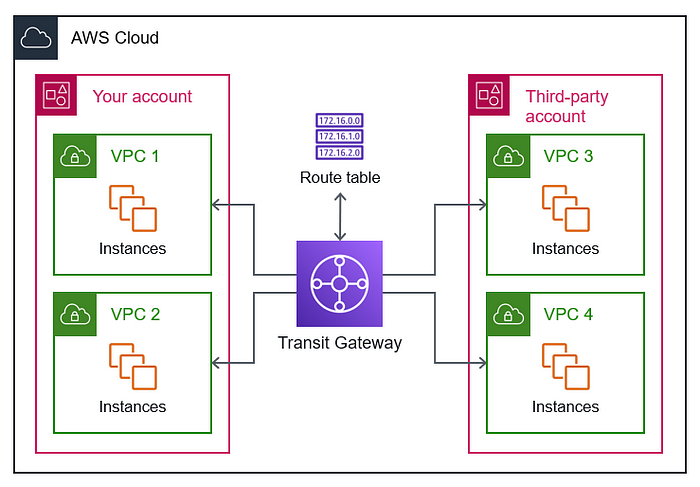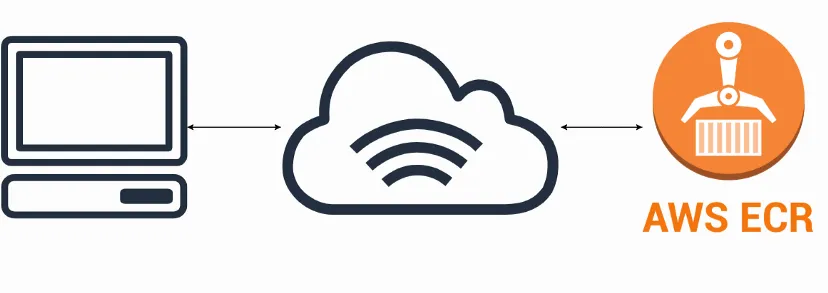Amazon Web Services (AWS) provides a robust set of networking services to enable seamless communication between resources in a Virtual Private Cloud (VPC).
Two popular options for connecting VPCs are VPC peering and Transit Gateway.
Let’s go over some key differences between the two.
What is VPC Peering?
 https://disaster-recovery.workshop.aws/en/services/networking/vpc/vpc-peering.html
https://disaster-recovery.workshop.aws/en/services/networking/vpc/vpc-peering.html
VPC peering allows direct communication between two VPCs. It is a one-to-one connection, meaning you need to create peering connections for each pair of VPCs you want to connect.
VPC peering is relatively straightforward to set up. You establish a peering connection between two VPCs by configuring route tables and accepting connection requests.
In regards to latency, peering connections are generally low-latency since traffic travels directly between the peered VPCs without additional hops.
One thing to keep in mind is that VPC peering is not transitive. If you have multiple VPCs that need to communicate with each other in a hub-and-spoke topology, you must create separate peering connections for each pair.
One of the main issues with this solution is managing multiple peering connections, which can become complex as your network grows. This can lead to administrative overhead and increased potential for misconfigurations.
As for cost, the data transfer costs are incurred for traffic that flows between peered VPCs. This can be a consideration in your cost management strategy.
When to use VPC Peering?
VPC peering is a good option for connecting two VPCs when you need a simple, one-to-one connection with low latency. For example, you might use VPC peering to connect a production VPC to a development VPC.
What is AWS Transit Gateway?
Transit Gateway is designed to simplify and centralize network connectivity. It acts as a hub that connects multiple VPCs, VPNs, and Direct Connect connections, making it a one-to-many or many-to-many solution. This allows TG to simplify network management by providing a single point of connectivity. You configure routing once and can connect numerous VPCs.
While Transit Gateway introduces an additional network hop compared to VPC peering, the impact on latency is typically minimal and well within acceptable limits.
In regards to traffic routing, Transit Gateway supports transitive routing, allowing traffic to flow between any attached VPCs, even if there is no direct peering connection between them. This makes it ideal for hub-and-spoke or full-mesh network architectures. Plus, this service scales easily, supporting hundreds of VPCs, making it suitable for large and complex network infrastructures.
As for cost, data transfer costs for traffic within Transit Gateway are generally lower than using VPC peering for the same level of connectivity due to its hub-and-spoke architecture.
When to use Transit Gateway?
Transit Gateway is a good option for connecting multiple VPCs together in a scalable and transitive way. It is especially well-suited for hub-and-spoke or full-mesh network architectures. If you have a complex network or need to connect a large number of VPCs, Transit Gateway is a good choice.
It is also a good choice for organizations that need to connect their VPCs to on-premises networks or to other AWS services, such as AWS Direct Connect and AWS VPN. Transit Gateway provides a central point of connectivity for all of these resources, making it easier to manage and secure your network.
Choosing the Right Solution
The choice between VPC peering and Transit Gateway depends on your specific requirements and network design. Here are some considerations to help you decide:
Simple vs. Complex Networks:
For smaller, less complex networks with only a few VPCs that need to communicate, VPC peering might suffice. However, if your network is larger, more complex, or needs transitive routing, Transit Gateway is likely the better choice.
Scalability:
Transit Gateway is the clear winner for scalability. If your network is expected to grow, or if you’re unsure about its size in the future, choosing Transit Gateway can save you from the complexities of managing numerous peering connections.
Cost:
Transit Gateway often provides cost savings in terms of data transfer costs, especially in scenarios with multiple VPCs. Consider your budget and how data transfer charges might impact it.
Transitive Routing:
If you require transitive routing (i.e., traffic can flow between VPCs without direct peering connections), Transit Gateway is the way to go.
Conclusion
Both services are valuable tools for connecting VPCs in AWS, but they serve different purposes. While VPC peering is a good option for simple, one-to-one connections, Transit Gateway is a better choice for complex, scalable, and transitive network architectures.
By understanding the differences between these two solutions, you can make informed decisions to meet your specific networking needs on AWS.



